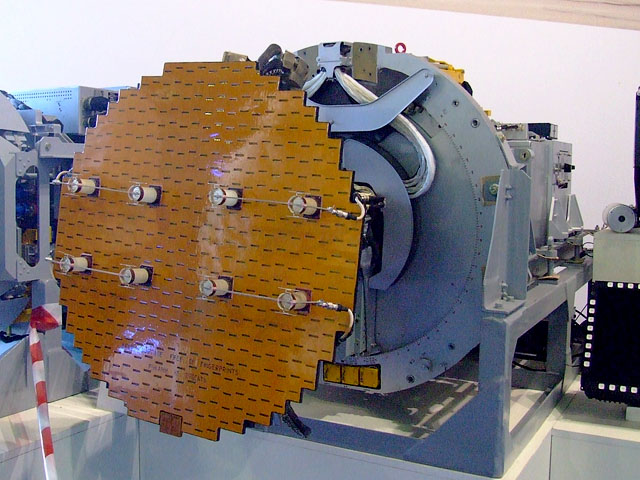|
Radar Scalloping
Scalloping is a radar phenomenon that reduces sensitivity for certain distance and velocity combinations. The name is derived from the appearance of areas that are scooped out of graphs that indicate radar sensitivity. Moving objects cause a phase-shift within the transmit pulse that produces signal cancellation. This phenomenon also has detrimental effects on moving target indicator systems, where the detection scheme subtracts signals received from two or more transmit pulses. Definition There are two different types of radar scalloping. * Intra-pulse * Inter-pulse Intra-pulse Scalloping This occurs when the radial velocity of the target induces a phase shift near 360 degrees within the reflected pulse, which induces signal cancellation in the receiver. Intra-pulse radar scalloping begins to become a concern above the following velocity. :Velocity > \left (\frac \right) Scalloping occurs at 150 km/s for an L-band radar with a 1 microsecond pulse. Inter-pulse Scallop ... [...More Info...] [...Related Items...] OR: [Wikipedia] [Google] [Baidu] |
Radar
Radar is a system that uses radio waves to determine the distance ('' ranging''), direction ( azimuth and elevation angles), and radial velocity of objects relative to the site. It is a radiodetermination method used to detect and track aircraft, ships, spacecraft, guided missiles, motor vehicles, map weather formations, and terrain. The term ''RADAR'' was coined in 1940 by the United States Navy as an acronym for "radio detection and ranging". The term ''radar'' has since entered English and other languages as an anacronym, a common noun, losing all capitalization. A radar system consists of a transmitter producing electromagnetic waves in the radio or microwave domain, a transmitting antenna, a receiving antenna (often the same antenna is used for transmitting and receiving) and a receiver and processor to determine properties of the objects. Radio waves (pulsed or continuous) from the transmitter reflect off the objects and return to the receiver, giving ... [...More Info...] [...Related Items...] OR: [Wikipedia] [Google] [Baidu] |
Pulse Repetition Frequency
The pulse-repetition frequency (PRF) is the number of pulses of a repeating signal in a specific time unit. The term is used within a number of technical disciplines, notably radar. In radar, a radio signal of a particular carrier frequency is turned on and off; the term "frequency" refers to the carrier, while the PRF refers to the number of switches. Both are measured in terms of cycle per second, or hertz. The PRF is normally much lower than the frequency. For instance, a typical World War II radar like the Type 7 GCI radar had a basic carrier frequency of 209 MHz (209 million cycles per second) and a PRF of 300 or 500 pulses per second. A related measure is the pulse width, the amount of time the transmitter is turned on during each pulse. After producing a brief pulse of radio signal, the transmitter is turned off in order for the receiver units to detect the reflections of that signal off distant targets. Since the radio signal has to travel out to the target and back ... [...More Info...] [...Related Items...] OR: [Wikipedia] [Google] [Baidu] |
Pulse-Doppler Radar
A pulse-Doppler radar is a radar system that determines the range to a target using pulse-timing techniques, and uses the Doppler effect of the returned signal to determine the target object's velocity. It combines the features of pulse radars and continuous-wave radars, which were formerly separate due to the complexity of the electronics. The first operational pulse-Doppler radar was in the CIM-10 Bomarc, an American long range supersonic missile powered by ramjet engines, and which was armed with a W40 nuclear weapon to destroy entire formations of attacking enemy aircraft. Pulse-Doppler systems were first widely used on fighter aircraft starting in the 1960s. Earlier radars had used pulse-timing in order to determine range and the angle of the antenna (or similar means) to determine the bearing. However, this only worked when the radar antenna was not pointed down; in that case the reflection off the ground overwhelmed any returns from other objects. As the ground moves at th ... [...More Info...] [...Related Items...] OR: [Wikipedia] [Google] [Baidu] |
Pulse Compression
Pulse compression is a signal processing technique commonly used by radar, sonar and Ultrasound, echography to either increase the range angular resolution, resolution when pulse length is constrained or increase the Signal-to-noise ratio, signal to noise ratio when the peak power and the Bandwidth_(signal_processing), bandwidth (or equivalently range resolution) of the transmitted signal are constrained. This is achieved by modulation, modulating the transmitted pulse and then Cross-correlation, correlating the received signal with the transmitted pulse. Simple pulse Signal description The ideal model for the simplest, and historically first type of signals a pulse radar or sonar can transmit is a truncated sinusoidal pulse (also called a CW --carrier wave-- pulse), of amplitude A and carrier frequency, f_0, truncated by a rectangular function of width, T. The pulse is transmitted periodically, but that is not the main topic of this article; we will consider only a single ... [...More Info...] [...Related Items...] OR: [Wikipedia] [Google] [Baidu] |
Moving Target Indicator
Moving target indication (MTI) is a mode of operation of a radar to discriminate a target against the clutter. It describes a variety of techniques used for finding moving objects, like an aircraft, and filter out unmoving ones, like hills or trees. It contrasts with the modern stationary target indication (STI) technique, which uses details of the signal to directly determine the mechanical properties of the reflecting objects and thereby find targets whether they are moving or not. Early MTI systems generally used an acoustic delay line to store a single pulse of the received signal for exactly the time between broadcasts (the pulse repetition frequency). This stored pulse will be sent to the display along with the next received pulse. The result was that the signal from any objects that did not move mixed with the stored signal and became muted out. Only signals that changed, because they moved, remained on the display. These were subject to a wide variety of noise effects th ... [...More Info...] [...Related Items...] OR: [Wikipedia] [Google] [Baidu] |
Pulse-Doppler Radar
A pulse-Doppler radar is a radar system that determines the range to a target using pulse-timing techniques, and uses the Doppler effect of the returned signal to determine the target object's velocity. It combines the features of pulse radars and continuous-wave radars, which were formerly separate due to the complexity of the electronics. The first operational pulse-Doppler radar was in the CIM-10 Bomarc, an American long range supersonic missile powered by ramjet engines, and which was armed with a W40 nuclear weapon to destroy entire formations of attacking enemy aircraft. Pulse-Doppler systems were first widely used on fighter aircraft starting in the 1960s. Earlier radars had used pulse-timing in order to determine range and the angle of the antenna (or similar means) to determine the bearing. However, this only worked when the radar antenna was not pointed down; in that case the reflection off the ground overwhelmed any returns from other objects. As the ground moves at th ... [...More Info...] [...Related Items...] OR: [Wikipedia] [Google] [Baidu] |





